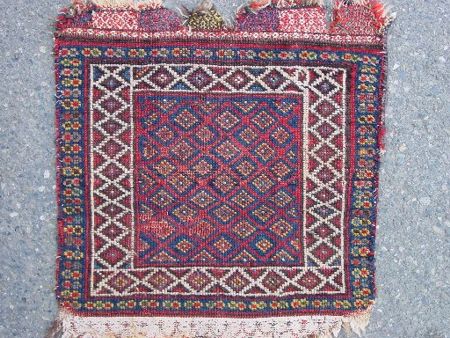
Undepressed warp, red wefts:
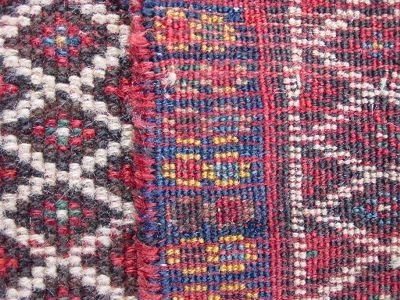
The light brown color around the rosettes is a natural, undyed wool, not a faded synthetic.
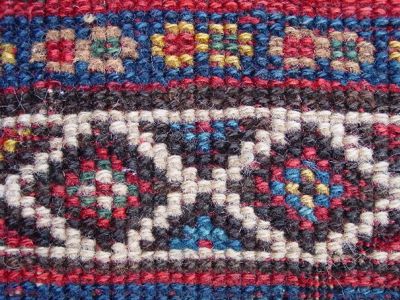
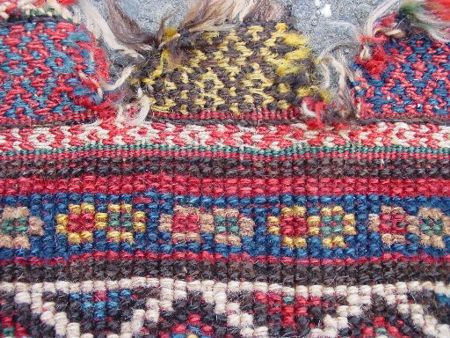
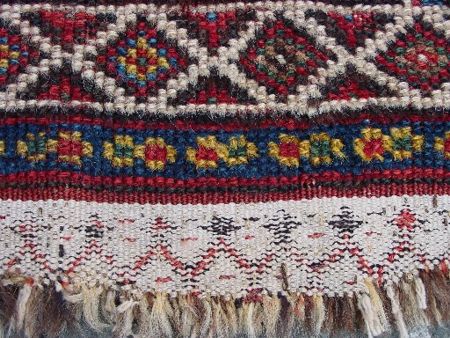
Comments? Questions? Insights?
Patrick Weiler
Varamin Connection?
Here is a bag with Luri characteristics and possibly Varamin
provenance:
Undepressed warp, red wefts: 
The light brown color around the
rosettes is a natural, undyed wool, not a faded synthetic.


Comments? Questions?
Insights?
Patrick Weiler
Varamin is the breadbasket of Tehran, supplying it with grains and other
agricultural foodstuffs. It is situated 40km, about 25 miles, south of Tehran,
in a vast plain, at the edge of the large Central Desert.
The city of Varamin
itself currently has a population of around 85,000, not counting the hundreds of
villages surrounding it. When Tehran was chosen as the capital of Persia in
1795, the Varamin area absorbed a multitude of tribes, hundreds of villages,
numerous flocks and flourishing farms. Thousands of camels carried the grains
and food from the Varamin area to Tehran in saddle bags woven by the various
tribes of the area.
Lurs from near and Fars  came, too, along with Arabs, Kurds and
Turks. The saddlebags woven by the Varamin Lurs utilize the familiar western
Luri techniques of widely spaced weft wrappings and patches of pile at the
bottoms of the bags.
came, too, along with Arabs, Kurds and
Turks. The saddlebags woven by the Varamin Lurs utilize the familiar western
Luri techniques of widely spaced weft wrappings and patches of pile at the
bottoms of the bags.
Tanavoli, in his book Rustic & Tribal Weaves from
Varamin, says:
"Designs are also similar, being based on repeated vegetal,
animal and/or geometric motifs. The most obvious distinction is in the palette,
with Lori-Bakhtiari work from western Iran being darker and duller than that of
the Varamin Lors."
This photo from the salon shows the widely spaced weft
wrappings: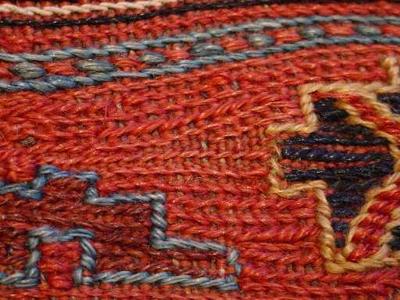
Tanavoli notes, in describing plate 67, a weft-wrapping mafrash of the
Turkmen gul type:
"The weft wrappings in this mafrash are spaced wrappings,
as in all other Varamini weft wrappings. All the tribes, including Shahsavans
who produce compact weft wrappings in their native land, have followed the Lori
tradition of spaced weft wrapping in Varamin."
The Arab tribes produced
these mafrash with Turkmen-like designs, such as this one seen earlier in the
salon: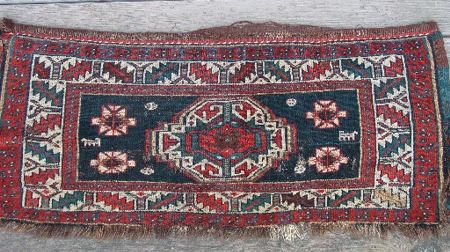
Tanavoli says:
"I know of no reliable sources for the
presence of Turkmen tribes in Varamin, and it is in any case most unlikely that
Sunni Turkmen tribes would have risked living among Varamini Shi'ites, so these
visual similarities have given rise to some understandable
confusion."
The square bag face in the first post above meets several of
the criteria of Varamin Lur weaving, including brighter colors, a typical
Varamin dark blue, repeated geometric motifs and the familiar Lur diagonal weft
wrapping design in the cotton flat weave strip at the bottom. It is 22" wide x
23" tall.
Interestingly, this construction - with a pile field and cotton
flat weave at the bottom- is the opposite of a "normal" Luri bag, which would
have been flat weave in the field and pile weave at the bottom!
Patrick
Weiler
Kurds of Varamin?
Hi Patrick,
I have a rug that has been described as potentially by the
Kurds of Varamin, and definitely has the right iconography etc. to support that
assertion.
This rug has interesting use of white cotton highlights in the
pile. Structurally, it is described as follows:
Warp: Wool (tan/brown), 3
strands, Z-spun, S-plied. Weft: Wool multiple colors, 2 strands, Z-spun,
S-plied, 3-5 shoots. Pile: Wool. Knot: Turkish, warps depressed, h.10 , v. 8, 80
KPSI.
I'll post pictures as soon as I'm able to get the link from
Steve.
Any thoughts on how this links up with your description in this
thread?
Best wishes
Danny
Here are the pictures: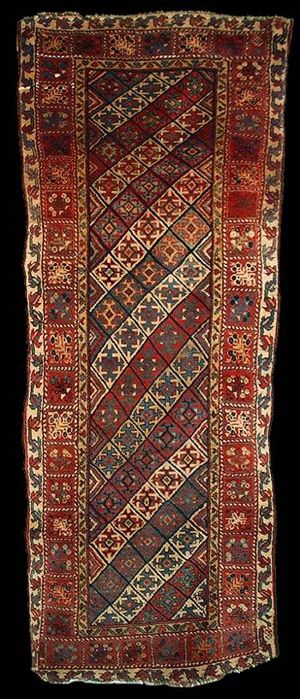
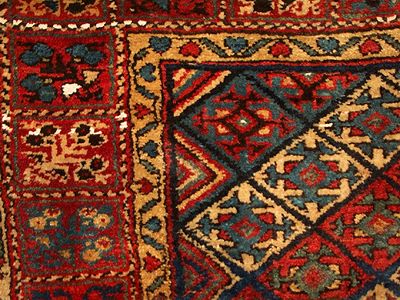
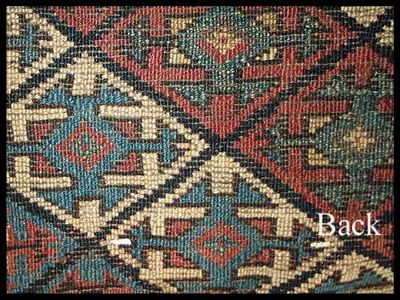
Varamin Structure
Danny,
Tanavoli indicates that all of the Varamin weaving groups use
the symmetric knot. So far, so good. The warps are usually flat or rarely
slightly depressed, possibly one strike against your rug. Most pile weavings
(Lurs are an occasional exception) have only one weft shoot between rows of
pile, probably another strike against a Varamin attribution. Interestingly, the
single weft was likely introduced to Varamin weavers by none other than the
western Kurds.
The weft is red only in Lur or Shahsavan weaves and these are
not exclusively red. Tanavoli says that most Varamin wefts are (this is
confusing) "dyed or undyed dark brown wool." Does he mean that they dyed the
wool dark brown?
So, your weaving does not fit most of the structural
categories, but we will need to see the evidence before coming to a
hypothetical, problematic, unsubstantiated conclusion.
Convincingly
yours,
Patrick Weiler
Pictures posted
Hi Patrick,
I have now posted the pictures of the Varamin Kurdish (?)
rug above.
Thanks
Danny
warps
Hi Danny and others:
Three strands of warps? I assume this means three
plies. Three plied warps is not consistent with Kurdish traditional weaving
which more typically has two ply warps - Z2S. The tan/brown color of the warps
is something we do find on Kurdish weaving as are the wefts as described. Warp
depression is usually an indication of a more village type weave. Many Kurdish
rugs have a flat back, but some villages used warp depression. I do not
associate this with Varamin, however. Danny's rug could be Kurdish but I would
think that if it is, it comes from further west based on the nice range and
saturation of color and that it is a village rug. The main border is fairly
distinctive and might help to place the rug. The field design is used in many
places.
Thanks, Michael
Looks Kurdish
Danny,
Michael's comments are very instructive. Note that at the edge
of the field of your rug, the diamond motif's become half-diamond chevrons
similar to those often found at the edges of the fields of diamond-lattice Jaf
Kurd bags.
Your field design is the same as that in plate 2 of the Tanavoli
book, except the diamond motifs in the Tanavoli piece are arranged in a
concentric diamond format instead of the diagonal stripes of your rug. The
half-diamonds at the edge of the field in the Tanavoli piece do not show the
chevron treatment.
The border, too, is different. Tanavoli says his was woven
by Kurds from Khorasan. They were first moved from west to east, then moved
partway back to Varamin.
Your border design does not show up in the new James
Burns book or in the Tanavoli book, although the minor border of the floral
meander (as seen in another post in this salon) is found in a few Kurdish rugs
from "Northern Kurdistan" in his book. He says it is called the "shudur" or
almond flower design.
Patrick Weiler
Agreed - its likely Kurdish
Michael and Patrick,
Thanks for your instructive comments. As you both
pointed out, this rug is likely kurdish, though per Michael's comments, it may
be a tad out of the strict kurdish weaving tradition.
If either of you
could post a picture of the rug in Mr. Tanavoli's book, that would be
terrific.
Do either of you have a theory on the border of this rug? It
was described to me as an early border sometimes found on "weeping willow" or
Bid Majnum kurdish rugs from NW Iran.
Also, this border would probably
be the last strike against a possible Luri connection, right?
Best
wishes
Danny
I think the rug is Lur. The main border is definitely found in Lur weaving,
although not specificaly Varamin Lur. The field and outside border is a Qashqa'i
combination. I have scanned a pertinent photo and will email it to Steve. John
Collins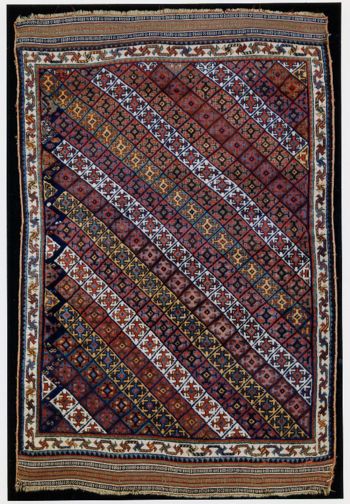
Qashqa’i gabbeh, c1860; 4’10” x 6’7”
Warp: wool; ivory; 2
ply; slight depression
Weft: wool; 2 shoots; red
Pile: wool; symmetrical
knot; 7H x 7V= 49 kpsi
Selvedge: bundle of 2 cables of warps with wefts
passing over; extra wrapping in alternating strands of red and yellow
wool
Literature: WOVEN GARDENS, Plate 30; GABBEH, Plate 28; HERRMANN VIII,
Plate 84
Hi Danny and all,
If it's a Luri, or a Qashqai, this Luri or Qashqai
didn't understand the
2 birdheads-on-a-pole-looking-the-same-direction
pattern.
The inside border shows a hartlike pattern.
This kind
can be seen in old Hamadan district rugs as well. It looks like a pear design.
Only there.
The main border could be everything. Think the weaver wanted to
show flowers?
So, if it isn't Luri, Qashqai or Hamadan district?
Maybe
Kurdish?
Aah...Shasevan!
A cross on a square. The half diamonds? 
Best regards,
Vincent
hi all
well !!!
at least we know it's not anatolian... ...
yet....
i guess this goes a long way to demonstrating the extreme
difficulties in making a positive attibution.
a kurdoqashvarlurshavan.
from somewhere west of beijing, east of paris.
danny - that's a really
nice rug you have. looks kurdishy to me. but then again that's probably because
i like kurdish rugs :-)
question - would the size of the rug have
anything to do with the equation? probably not. stupid question
!
richard
This is getting interesting!
Thanks, everybody, for your input.
John's rug bears a remarkable
similarity to mine in the field and minor border compositions. It would be
interesting to see the main border composition in another rug as well. John
mentioned he's seen it in Lur rugs. If anyone has a picture handy, it would be
fun to see it.
The size of my rug, if it helps, is 3' x 7'9". Both ends
have minor losses. Its hard to speculate whether mine had one or both ends in a
kilim finish like one end of John's rug.
Like Richard, I too tend to
"want" my rug to be Kurdish, but I love Luri and Qashqai rugs too, so I'll take
it either way!
Best wishes
Danny
Could be that
Dear People:
To be precise, I wrote Danny's rug "could" be Kurdish and
that if it is, it must come from further west. The three plied warps are a big
negative indicator of the rug being Kurdish. I also still think the main border
is fairly distinctive and is the best help at this point to more narrowly place
the rug. If John has seen this border on Lur rugs then that seems to be a fairly
strong indicator. Like Vincent I see that inner minor border as more of a
Hamadan and Southern Kurdistan motif. I also have a vague recollection of the
main border on rugs from the area. However, in making any final judgments always
go back to structure and color.
Perhaps we should just call it a Lak or
Lakistani rug?!?
Regards, Michael
Dear Danny,
Your rug is Luri. There are many similarities between Luri
and Qashqa’i color palettes and iconographies. The differentiating feature is
sometimes only the fineness. Your rug did not have end finishes like the one I
posted. In all likelihood it had finishes similar to the bag that began this
thread. I will post a picture if a Luri Varamin with decoration similar to that
bag. I also have a picture (which may take me some time to find) which shows
your rug’s main border in an obviously Luri piece.
Best Wishes, John
Collins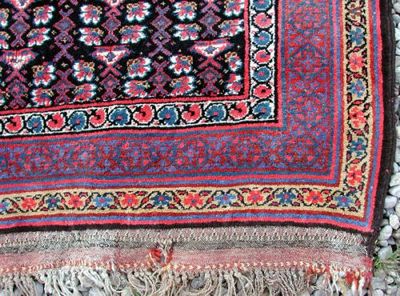
Note
the triangle decoration which also appears in the first
bag.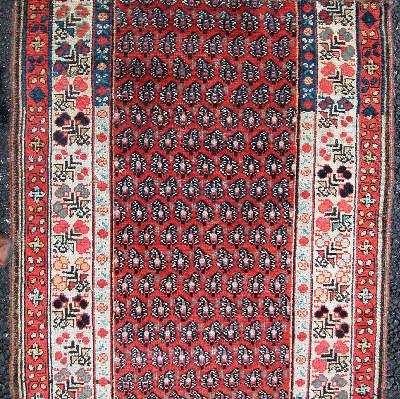
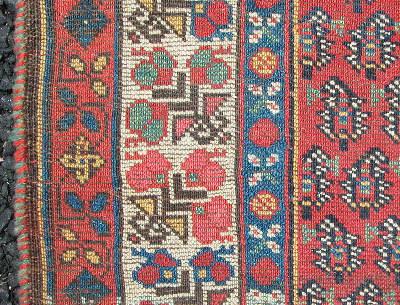
I think we may have a ringer!
John,
Thanks for posting the pictures. Remarkable
similarities!
So does the structure described for my rug sound more like
a Luri than a Kurdish structure to you?
Best wishes
Danny
Dear Danny,
Your structure is precisely Lur. I don’t know which
Varamin groups Patrick was quoting Tanavoli on, but the single weft “rule” has
not been my experience. In the eleven various Luri rugs I documented in FLOWERS
OF THE DESERT, I believe only two were single wefted. Your close-up of the back
seems to show grayish wefts (you said multi-color in your text). The grayish is
consistent with Luri Varamin, as are the dark brown in both warp and weft. Your
knot count is typical also (the FOD examples ranged from 56 to 72).
John
Collins
Single weft
John,
The Arab Varamin mafrash shown above is single wefted, as is a
Varamin khorjin I have.
Michael Craycraft, in ORR volume 9, number 6,
August/September 1989, described over 100 varamin weavings of the type that
"many of which bear archaic and contemporary Turkoman iconography."
(This design type is said by Tanavoli to most likely be woven by Arab
Varamin weavers, so the Lurs would not share this high of a percentage of single
wefted weavings)
"Eighty-three percent (69/83) are single wefted....As
was the case with design elements, torbas were the strictest with 95% being
single wefted....There is a tendency to insert a few dyed or colored wefts in
the weaving (60%) or leave them all natural (26.5%). Ten examples contained 100%
dyed wefts."
He does not say what color the wefts were dyed!?
Tanavoli
says, in the page describing the rugs of Varamin:
"The Kurds and the Osanlu
Turks weave the majority of the regions's pile rugs. All groups including Kurds,
Lors, Shahsavan and Arabs use the symmetric knot. Warps are most often on one
level, or, rarely, slightly depressed. The majority of pile weaves have one weft
shoot between rows of knots. Single-wefting was probably introduced to Varamin
by the western Kurds. Double wefted rugs are not rare either, especially among
the Lors and Turks."
So, the experience you had, with only two of eleven
Luri Varamin rugs being single wefted is right in line with
expectations.
Danny,
Another indicator of your rug being Lur rather
than Kurd is the length of over two times the width, a common Luri
characteristic. Here is the photo of the Kurdish rug from the Tanavoli book,
plate 2: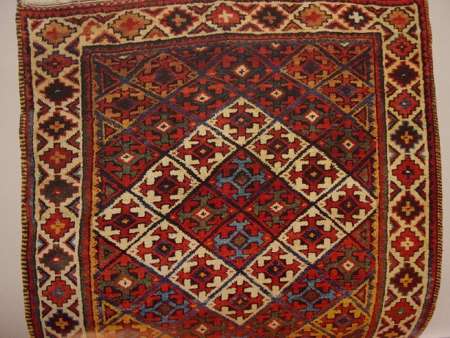
Patrick Weiler
Well well!
Thanks, everyone, for your comments on this rug. It seems we have borders and
structure pointing to Luri and a field composition that could be either Luri or
Kurdish.
I appreciate everyine's input. Thanks.
I've started
another thread with a different rug...would you speculate that this one is Luri
too?
Best wishes
Danny
Kurd or Lur
Danny,
Your rug illustrates perfectly one of the reasons for this
salon. The question was asked several months ago if there was really any
confusion between Kurdish and Luri rugs. They both seemed so different from one
another. As we have seen, there are a lot of rugs and bags that are difficult to
differentiate between Kurd and Lur. The expertise developed by the top dealers,
over years of handling these types of rugs, is invaluable. Even experts in
paintings often cannot tell who painted an old master sometimes, which is why
there are ocassional findings of paintings of great merit, hidden in plain sight
for generations.
A case last year of a Reubens rediscovered sold for $76
milllion.
http://www.msnbc.com/news/778922.asp?cp1=1#BODY
Perhaps
your Luri rug is worth that much, too?
Patrick Weiler
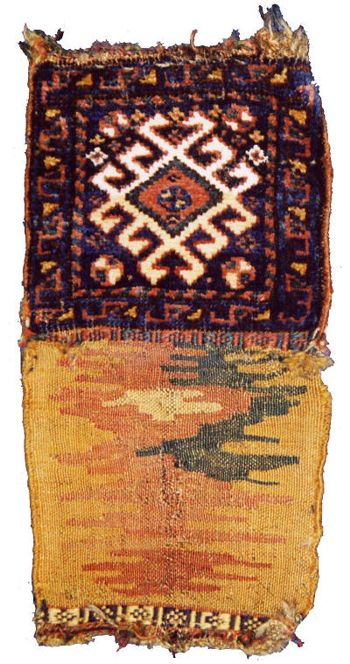
Dear
Danny,
Here is a beautiful small Luri bag fron the 19th century which
also uses cotton for part of the white pile.
John Colllins
Thanks
Thanks to everyone for contributing to this diagnosis. Its interesting to
learn how difficult it is to make attributions.
Patrick, thanks for the
painting reference. I suppose our little tribal pieces may achieve such
significance in a 1000 years!
John, that little bag is a stunner. I loved
how they've used cotton to contrast the whites in the palette.
Best
wishes
Danny
Why White
John,
I do not know how unusual it is for Luri weavers to use cotton
in the pile fields of their weavings. The two small khorjins from the salon do
not have any, nor does the large khorjin, but the large khorjin does use cotton
for the whites in the sumak areas. You can see this in the lower right hand
corner of this photo: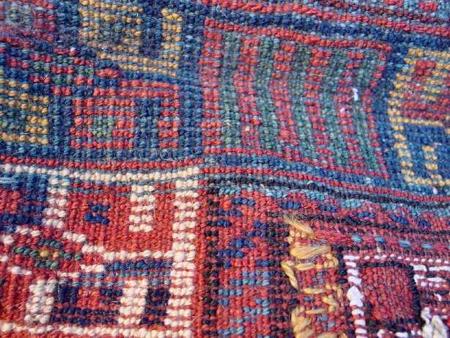
Why do Luri weavers sometimes use white cotton in the pile? The
most likely explanation is because it really did not matter very much to them.
As James Opie has said, Luri weavers were not weaving these things for the
market. Goods for market required that appearances in terms of absolute symmetry
and artistic integrity were more important than the cultural integrity of the
iconography and the sometimes posited apotropaic asymmetry - the purposeful
non-alignment of things to deflect the Evil Eye.
(think of the metallic
"chaff" that fighter jets spew out to deflect incoming enemy
missiles)
Perhaps also cotton was a luxury item to wandering nomads and was
used the same way small amounts of silk was used in other tribal weavings.
In
John's bag, since fully half of the major medallion is in cotton, it has a
striking artistic effect of making the bag more noticeable. We know that the
owners of these small containers carried them with pride. This one is just that
much more special because of the cotton. This added cotton may also have been a
way for the owner to differentiate her bag from the many other bags of similar
size and design. Think of a gathering of women getting up to leave the party.
Now, which bag is mine?
Patrick Weiler
Unfortunately, the use of cotton as pile does not tell us who made a piece.
It is frequently found in Luri and tribal Bakhtiyari work, and in many Kurd
pieces. It is not uncommon to see it used in many different Persian village
pieces as well. In the vast majority of these cases it seems to be used
randomly. The great exception to this are soumac bags where cotton is often used
for all the white surface for contrast effect.
A customer of mine just
reminded me of a dozar which went through the gallery some 5 years ago which had
some cotton pile. Upon close examination, we discovered at that time that the
cotton had a printed pattern on it. It seemed to be re-cycled clothing
material!
John Collins
The End of the Road
Danny,
This photo shows what is commonly known as a "Shiraz" rug. It
uses the same medallion as your Luri rug, both in the center of the 3 medallions
and on either side of the medallion pole the length of the field: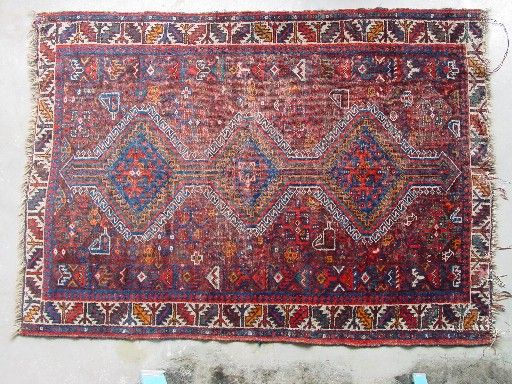
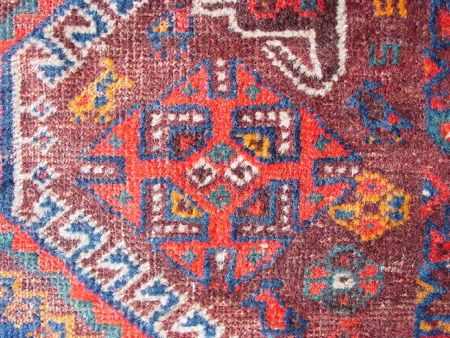
You can easily see the Luri-d
orange, firmly establishing this weaving at about early mid-twentieth century.
It is rather worn, as it was probably not a valuable rug right out of the
starting gate. It has the "cheerleader and pom-pom" main border. You may also
note the diamond appendages growing out of the pole at the left side of the
second photo. These diamonds are also found on the gabbeh, surrounding the
square devices in the medallions.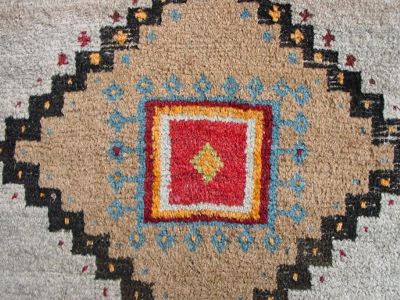
It also has the familiar
bird's-head / latch hooks surrounding the medallions that is most common to Luri
weavings, along with a flock of small chickens in the field.
This example
is probably near the end of the timeline for Luri rugs. This one is smaller in
size than a typical, earlier Luri rug, uses synthetic dyes and less substantial
wool - this wool is softer and more easily worn than the heavy, richer rugs of
before, and has become more standardized in design like the thousands of generic
Shiraz rugs woven for the market. Perhaps it was woven by a settled Luri weaver,
a generation removed from the vital, nomadic-existence lifestyle that had been
followed by her ancestors as far back as their stories take them.
Patrick
Weiler
flatweave pattern
The following photo shows a khorjin from the Tanavoli book. It is plate 39,
described as Kurdish or Lori, ca. 1900, 2'2" x 4'2".
Notice the white
zig-zag border. This is the same design as you will see at the bottom of the
weaving shown at the top of this thread.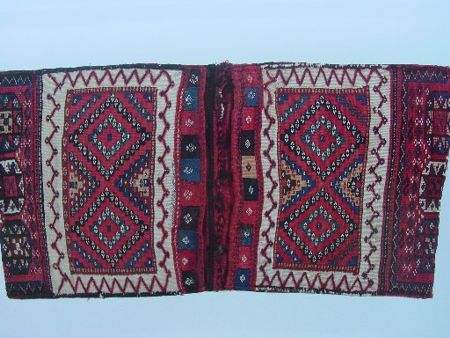
In this case it is, as I noted,
on a khorjin with a flatweave front with a pile panel at the bottom.
Here
is the original bag showing the panel at the bottom:
This same design is seen in
"common" Bakhtiyari and Luri bags, too.
Patrick Weiler